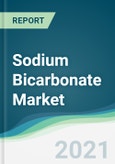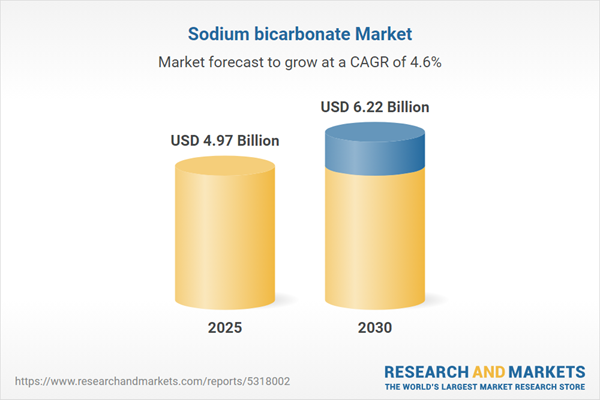The global sodium bicarbonate market is poised for significant growth, driven by its versatile applications across food, animal feed, pharmaceuticals, personal care, and cleaning industries. Known as baking soda, sodium bicarbonate is a white crystalline powder used as a leavening agent, acidity regulator, and deodorizing agent. The market is propelled by rising demand for bakery products, animal feed, and over-the-counter (OTC) drugs, alongside increasing consumer focus on health, hygiene, and convenience. Supportive government regulations, such as the EU’s E500(ii) designation for food-grade sodium bicarbonate, further enhance market prospects. However, environmental concerns, health hazards, and the emergence of substitutes pose challenges to growth.
Market Drivers
The surge in demand for processed and packaged foods, particularly bakery and confectionery items, is a key driver, as sodium bicarbonate serves as a critical leavening agent. The growing animal feed industry also boosts the market, with sodium bicarbonate used to regulate acidity and enhance digestion, eggshell strength, and milk yield in livestock. Rising meat consumption globally further supports this demand. Additionally, increasing disposable incomes and improving living standards, especially in developing regions, drive the adoption of sodium bicarbonate in personal care products like deodorants and detergents. The expansion of e-commerce and retail channels enhances market accessibility, fueling growth.Market Constraints
Environmental concerns related to sodium bicarbonate production, such as carbon emissions, and potential health risks from overuse in certain applications, limit market expansion. The rise of eco-friendly substitutes and alternative chemicals in food and cleaning applications also poses a competitive threat. Addressing these challenges through sustainable production methods is critical for market players.Market Segmentation
The sodium bicarbonate market is segmented by grade, form, application, and geography. Grades include food, pharma, feed, and technical, with feed grade leading due to high demand in animal nutrition. Forms encompass slurry, crystal/powdered crystal, and liquid, with crystal/powdered crystal dominating. Applications span food, personal care, pharmaceuticals, animal feed, cleaning agents, and flue gas treatment, with food and animal feed driving significant growth. Geographically, the market covers North America, Europe, Asia-Pacific, South America, and the Middle East and Africa.Geographical Outlook
The Asia-Pacific region holds the largest market share, driven by high population growth, increasing demand for processed foods, and expanding pharmaceutical and personal care sectors in countries like China and India. Europe follows, with strong demand for detergents in countries like Germany and the UK. North America, South America, and the Middle East and Africa are expected to see steady growth, supported by rising consumer awareness and retail expansion.Competitive Landscape
Key players like Solvay, Tata Chemicals, and Church & Dwight focus on expanding production capacity and adopting sustainable practices to meet global demand. Companies are investing in innovative applications, such as sodium bicarbonate for flue gas treatment and animal nutrition, to strengthen their market positions. Strategic collaborations and capacity expansions are common to address diverse industry needs.Opportunities and Challenges
Opportunities lie in leveraging e-commerce growth and developing eco-friendly production methods to align with sustainability goals. Challenges include mitigating environmental impacts and competing with substitutes. Industry experts should prioritize sustainable innovations and market expansion in high-growth regions to capitalize on the sodium bicarbonate market’s dynamic potential.Key Benefits of this Report:
- Insightful Analysis: Gain detailed market insights covering major as well as emerging geographical regions, focusing on customer segments, government policies and socio-economic factors, consumer preferences, industry verticals, and other sub-segments.
- Competitive Landscape: Understand the strategic maneuvers employed by key players globally to understand possible market penetration with the correct strategy.
- Market Drivers & Future Trends: Explore the dynamic factors and pivotal market trends and how they will shape future market developments.
- Actionable Recommendations: Utilize the insights to exercise strategic decisions to uncover new business streams and revenues in a dynamic environment.
- Caters to a Wide Audience: Beneficial and cost-effective for startups, research institutions, consultants, SMEs, and large enterprises.
What do businesses use our reports for?
Industry and Market Insights, Opportunity Assessment, Product Demand Forecasting, Market Entry Strategy, Geographical Expansion, Capital Investment Decisions, Regulatory Framework & Implications, New Product Development, and Competitive Intelligence.Report Coverage:
- Historical data from 2022 to 2024 & forecast data from 2025 to 2030
- Growth Opportunities, Challenges, Supply Chain Outlook, Regulatory Framework, and Trend Analysis
- Competitive Positioning, Strategies, and Market Share Analysis
- Revenue Growth and Forecast Assessment of segments and regions including countries
- Company Profiling (Strategies, Products, Financial Information, and Key Developments among others)
The Sodium Bicarbonate Market is analyzed into the following segments:
- By Grade
- Food Grade
- Pharma Grade
- Feed Grade
- Technical Grade
- By Form
- Slurry
- Crystal/Powdered Crystal
- Liquid
- By Application
- Food
- Personal Care/Cosmetics
- Pharmaceuticals
- Flue Gas Treatment
- Animal Feed
- Cleaning Agent/Detergent
- Chemical
- Others
- By Type
- Sodium Carbonate Method Type
- Sodium Hydroxide Method Type
- Nahcolite Extraction Type
- By Geography
- North America
- USA
- Canada
- Mexico
- South America
- Brazil
- Argentina
- Others
- Europe
- Germany
- France
- United Kingdom
- Spain
- Others
- Middle East and Africa
- Saudi Arabia
- UAE
- Others
- Asia-Pacific
- China
- India
- Japan
- South Korea
- Indonesia
- Thailand
- Others
- North America
Table of Contents
Companies Mentioned
- Solvay
- Tata Chemicals Ltd.
- Pfizer Inc
- Genesis Energy, LP
- Tosoh Corporation
- Natrium Products Inc.
- Tokuyama Corporation
- Trade House Bashkhim
- Natural Soda, LLC
- AG CHEMI GROUP s.r.o.
- GHCL Limited
- CIECH S.A.
- Church & Dwight Co., Inc.
Table Information
| Report Attribute | Details |
|---|---|
| No. of Pages | 146 |
| Published | November 2025 |
| Forecast Period | 2025 - 2030 |
| Estimated Market Value ( USD | $ 4.97 Billion |
| Forecasted Market Value ( USD | $ 6.22 Billion |
| Compound Annual Growth Rate | 4.6% |
| Regions Covered | Global |
| No. of Companies Mentioned | 13 |









